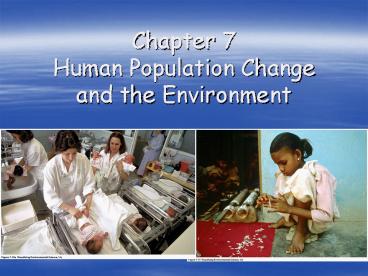Chapter 7 Human Population Change and the Environment - PowerPoint PPT Presentation
1 / 38
Title:
Chapter 7 Human Population Change and the Environment
Description:
Largest population in the world. 1971: government involved. 1979. More aggressive plan ... Most large cities are in developing countries ... – PowerPoint PPT presentation
Number of Views:146
Avg rating:3.0/5.0
Title: Chapter 7 Human Population Change and the Environment
1
Chapter 7 Human Population Change and the
Environment
2
Population Growth In China
- Largest population in the world
- 1971 government involved
- 1979
- More aggressive plan
- One-child policy
- Why do it?
3
Population Growth In China
- 1984 program relaxed why?
- 1970 5.8
children/woman - 2006 1.7
children/woman - Ethical issues
4
Population Ecology
- Branch of biology
- Study of populations
- Individuals of a given species
- How they respond to the environment
- Look for similarities
5
How Populations Change
- Global scale dependent on two things
- Birth rate (b)
- Death rate (d)
- Growth rate (r)
- r b - d
6
How Populations Change
- Local populations
- Dispersal
- Immigration (i)
- Emigration (e)
7
Maximum Population Growth
- Biotic potential
- Maximum rate at which population can increase
- Determined by life history characteristics
- Large organisms ---gt smallest biotic potentials
- Microorganisms ---gt largest biotic potentials
8
Exponential Population Growth
- Optimal conditions
- Constant reproductive rate
- J-shaped curve
9
Environmental Resistance
- Unfavorable environmental conditions
- Prevent reproduction at biotic potential
- Examples?
- Environment controls population size how?
10
Carrying Capacity
- Largest population that can be sustained
indefinitely - Changes in response to environment
- J-shaped curve ---gt S-shaped curve
11
Carrying Capacity
- Populations are always changing
- Slightly above or below carrying capacity
- Too high ---gt crash
12
The Human Population
- Currently 6.5 billion
people - 7 billion by 2013
- Why the increase?
13
Thomas Malthus
- British economist
- Hypothesized that human population would be kept
in check how? - Thinking shaped by rapid urbanization
industrialization - Was he correct?
14
Projecting Future Population
- World growth rate has declined slightly
- Zero population growth
- Birth rate death rate
- End of 21st century
- U.N. predicts 7.9-10.9 billion by 2050
15
Earths Carrying Capacity
- 4 billion 16 billion people
- Why such a large range?
- What could happen to the environment?
- Have we already exceeded our carrying capacity?
16
Demographics
- Study of populations
- Highly developed countries
- Low birth rates
- Low infant mortality
- Longer life expectancies
- High GNI PPP
17
Demographics
- Less developed countries
- High birth rates
- High infant
mortality - Shortest life expectancies
- Low GNI PPP
18
Total Fertility Rate
- TFR average number of children born to each
woman - Replacement rate 2.1
- Current TFR
19
Demographic Transition
- Country moves from high birth and death rates to
low birth and death rates - Four stages
- Preindustrial
- Transitional
- Industrial
- Postindustrial
20
Demographic Transition
21
Demographic Transition
- Population is stabilizing in some countries
- Can all developing countries get there?
22
Age Structure Diagrams
23
Age Structure
- Number and proportion of people in each age group
in a population - Helps predict future growth
- Shape is important
- Pyramid fast growth
- Tapered bases slow or negative growth
24
Future Population Growth
- Determined by prereproductive individuals
- Developed vs. developing countries
25
Stabilizing World Population
- Dispersal is not a solution
- Increase the death rate?
- Reduce the birth rate!
26
Culture and Fertility
- Gender and society
- Different societies have different expectations
impacts fertility rates
27
Culture and Fertility
- High TFRs may be traditional
- High infant mortality rates
- Children can work
- Males more valued
- Religious values
- Changing traditions takes
time
28
Status of Women
- Gender inequality still exists
- Most developing countries
- More illiterate women
- Fewer women attend secondary school
- Limits women
29
Status of Women
- Low status of women is single most important
factor influencing TFR - Average age at marriage impacts TFR
- Sri Lanka 25 TFR 2.0
- Bangladesh 17 TFR 3.0
- More education
less children why?
30
Family Planning Services
- Prenatal care, proper birth spacing
- Healthier women ---gt healthier babies ---gt
fewer infant deaths ---gt lower TFR - Provide information and contraceptives
- Local social and
cultural beliefs
31
Government Policies Fertility
- Laws determining minimum marriage age
- Budget for family planning, education, health
care, old-age security - Economic rewards and penalties
- Many countries recognize the problem
32
Population and Urbanization
- Human population becoming more urbanized
- 79 U.S. population lives in cities why?
33
Urbanization Trends
34
Urbanization Trends
- Currently 47 worlds population lives in urban
areas - Most large cities are in developing countries
- If urban growth
is too fast, basic
services cannot
keep up
35
Environmental Problems of Urban Areas
- Encroachment into habitat
- Brownfields
- Long commute ---gt more air pollution
- Buildup of emissions
- Paved roads,
buildings affect
water flow
36
Environmental Benefits of Urbanization
- Compact development
- Tall, multiple-unit residential buildings are
close to shops and jobs - Connected by public transportation
- Reduces pollution
- Preserves rural areas
- Requires smart planning!
37
Case Study Curitiba, Brazil
- More than 2.5 million people
- Compact development
- Efficient mass transit system
- Big sidewalk connects downtown
38
Case Study Curitiba, Brazil
- Purchase of flood-prone properties
- Now, parks with bicycle paths
- Garbage Purchase
- People exchange garbage
for basic needs - Benefits people































